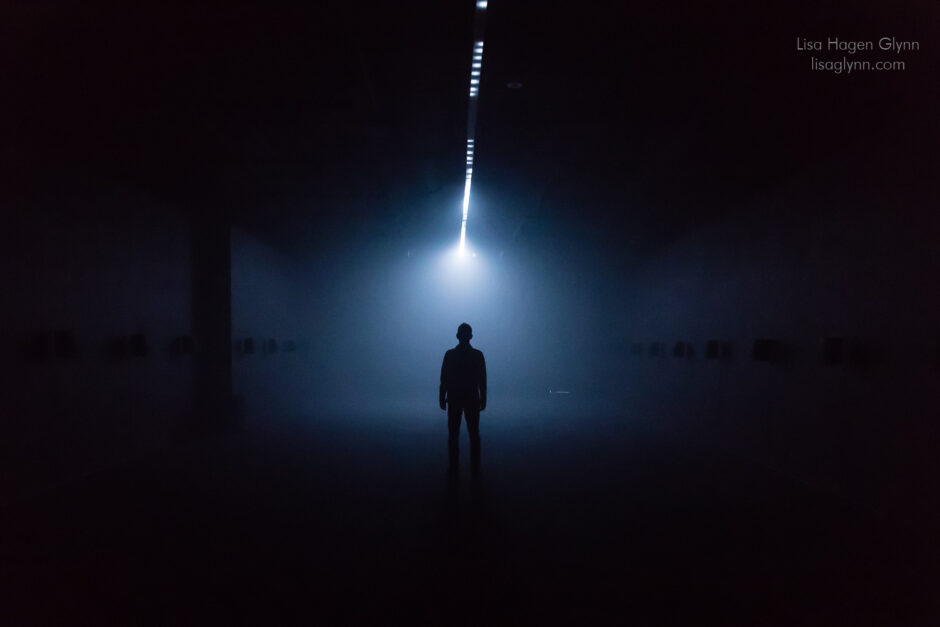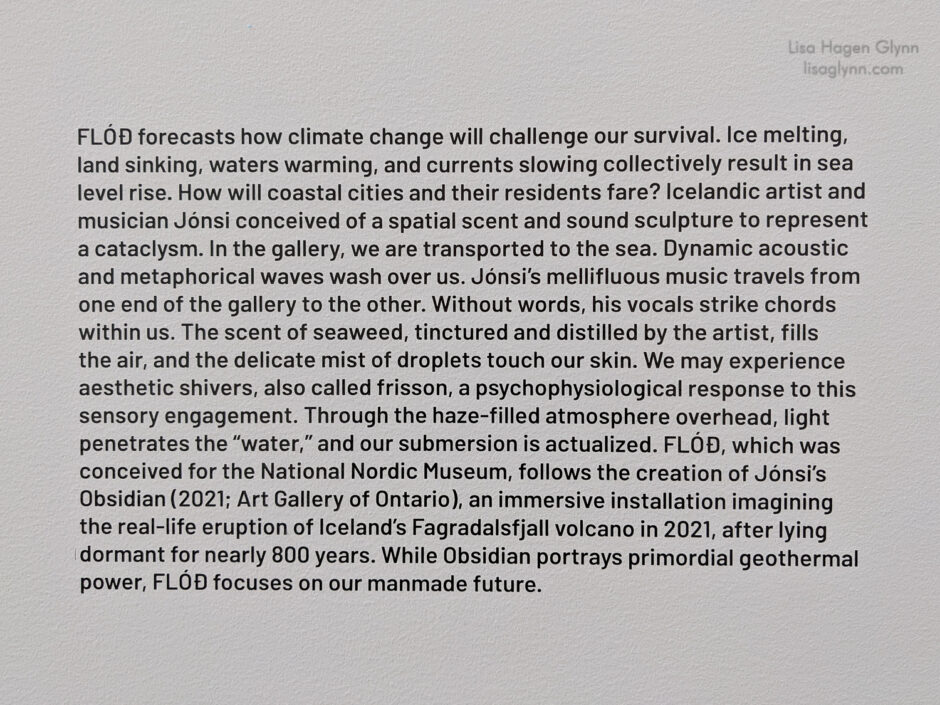Interview with Jónsi and Review of “FLÓÐ (Flood)”
March 20, 2023
By Lisa Hagen Glynn

Jónsi – photo by Lisa Hagen Glynn
Jónsi (Jón Þór Birgisson) – best known as lead vocalist for the Icelandic experimental-rock group Sigur Rós – has brought a new multisensory art exhibit to Seattle’s Ballard neighborhood. “FLÓÐ (Flood)” is Jónsi’s first U.S. installation, designed specifically for the National Nordic Museum.
Through sound, sight, and smell, the exhibit explores humanity’s impending demise from rising seas. Jónsi designed all the elements of the oceanic exhibit: composition and singing, a “big wave” of light that travels the length of the ceiling, and even a salty seaweed fragrance.
Entering the exhibit, visitors first notice a disorienting darkness. This casts uncertainty about the size of the room or any obstacles about the floor, which creates an intentional pause at the entryway for reorientation and engagement. As eyes adjust and an overhead strip of white lighting pulses, the space is revealed as a cavernous long room with speakers spaced along the walls. Save a few subwoofers, the floor is unobstructed, suitable for sitting or cautious lying down. Fog hangs in the air, illuminated by a distant blue glow, and visitors become silhouettes.

“FLÓÐ (Flood)” – photo by Lisa Hagen Glynn
The audio is felt as a physical presence, intense and all-encompassing. A creaking effect portends shattering icebergs, drones announce disaster, a mournful chorus emerges from crashing waves, and Jónsi’s choirboy voice arises transcendent. Moving throughout the room emphasizes shifting aural elements, adding a sense of position within the space. To truly immerse oneself requires at least the 25 minutes to complete the audio loop—but a longer visit to “FLÓД might even be meditative.
Most poignant is that visitors must become participants in the exhibit, altering the moment-to-moment experience within the room. With climate change, humanity’s outcomes are also collective, and it is impossible to remain just an observer.
“FLÓÐ (Flood)” runs through July 30. The National Nordic Museum is open 10AM-5PM Tuesday through Sunday. The special exhibit is included in the price of museum admission, or $5 on free first Thursdays.

“FLÓÐ (Flood)” – photo by Lisa Hagen Glynn
—
Jónsi spoke with Back Beat Seattle before his members-only opening on March 17. At that time, the exhibit was still being installed. [Note: Interview was edited for length and clarity.]
I understand that “FLÓД is a multisensory ocean exhibit. Why have you expanded from music into visual art and scent?
I’ve been doing music for so long – my whole life basically – so that comes pretty naturally, and I’m trying to expand on that. It’s so different when you play [music] live – you play one show, and then you leave, and you play your next show somewhere else – so it’s kind of nice to have a controlled space like a gallery where you can go deep into controlling where the sound comes from. I have, like, 36 speakers in the room [here]. It’s spatialized sound, so you can really control that aspect of it. It’s just really fun.
“When the big wave comes and like drowns us all in the end, we’re left with this briney destruction.”
Then I just love scents. I’ve been creating scents for 13 years now, perfumes and stuff like that. I like that aspect of it also. When you go into a museum it triggers different senses: When you walk in you smell something, and then you see something, and then you hear something. It’s kind of nice to move people if possible—that’s my goal, maybe. It’s so different when you go to a concert, you usually are kind of moved in some way – the loud music, the lights – it’s kind of nice to get that tiny bit into the museum space. It’s very different, but you know, you have that movement.
A different way of moving people. How did you create the seaweed scent for the exhibit?
It’s made from maybe 30 different molecules, and also a tincture of seaweed. I wanted to create a salty, briney, seaweed scent – mixed with destruction. So it’s smoke and a harsh element – pleasant, but not pleasant. It’s like when the big wave comes and like drowns us all in the end, we’re left with this briney destruction.
Tell me about the audio for the exhibit, which I understand includes field recordings and choral music.
Usually I start with just my voice. The human voice is such a basic thing to move people – anybody can connect with that, and it doesn’t need have to have any words or anything.
I usually start with a choir of like 16 voices and put it in different speakers, and then I sing on top. So it becomes a choiry moment. And then field recordings from different oceans around the world. And then also sensory sounds, ASMR , where you can really spatialize things in different speakers and it surrounds you.
The vocals then become almost part of the tone, or timbre, of the piece.
Ja, definitely. I have this beautiful memory of traveling with this Icelandic choir, Schola Cantorum [Reykjavicensis]. We were all wasted in some bar, and I said I would buy everyone shots if they would sing my favorite Icelandic choir song in a circle around me. It was such a beautiful moment, and I’m always trying to recreate that feeling. So [in the exhibit] you have different speakers and different voices surrounding you, all singing to you.
It just brings you right back. What are the challenges of composing music for an art installation?
It’s just a lot of practical things you need to be aware of—how the room is, the size, where you’re going to have the speakers, how far in between, and blah blah blah—just practical stuff, I guess.
You need to have a carpet on the floor so it’s not too echoey and you have more control over it. The first exhibition I did had a concrete floor and concrete walls, and it was just so echoey—I didn’t realize how echoey it would be. I was like, “Fuck. Okay, for the next one I need carpet.” [Laughs]
Your visual work tends to incorporate contrasting darkness and light, and I understand that will be true of “FLÓД as well. What personal meaning does this theme hold for you?
The darkness [is common to] sister cities Seattle and Reykjavik. We see a lot of depression in the wacky weather and darkness. People need to do stuff to be happy—to create music, or write, or anything to keep sane. [Laughs] A lot of that comes out in the artwork. It’s usually just black or white and not much color—sometimes, though.
And in your music as well.
Exactly, yeah!
You mentioned the key concept of the “big wave,” and you have called climate change a “dire reality.” How does “FLÓД encapsulate your fears about climate change?
Our weird lives now – maybe it’s just everybody in their lifetimes – get that thing where something needs to happen now, but nobody’s doing anything. We’re all just scrolling away on our phones and seeing all these disasters happening on our screens. But you feel helpless about it and don’t know what to do, and nobody seems to be doing anything – people in power aren’t doing anything. It just seems like a little bit bleak.
Your art raises that awareness.
I mean, I don’t know how much that will get through. But maybe. [Laughs]


“FLÓÐ (Flood)” – photos by Lisa Hagen Glynn